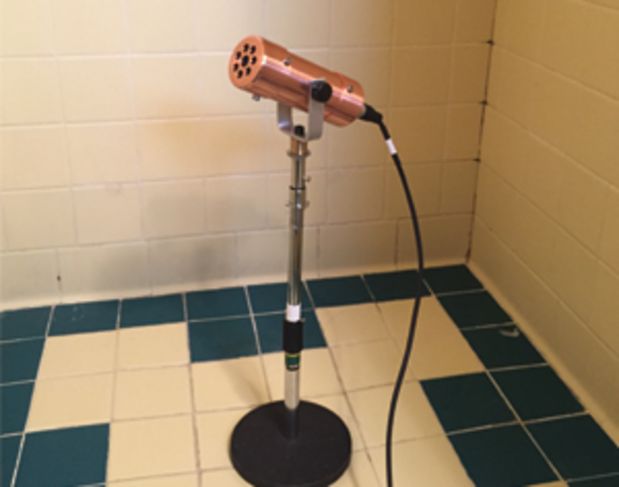
I sat down with Mark Pirro, bass guitarist for the Polyphonic Spree and Tripping Daisy, to talk about the greatest of DIY recording techniques: recording something in the bathroom.
Pirro had a completely unique take on the subject, using the bathroom as a mixdown echo chamber!
Some background first: Pirro is one of those sonic geniuses who always has an ear for the unique. When Polyphonic Spree frontman Tim DeLaughter was looking for a lo-fi vocal sound, Pirro invented the Copperphone, a microphone that uses components from vintage communications equipment to achieve a limited bandwidth frequency response similar to an AM radio or early recordings.
The Copperphone (and his other mics) are now handmade by his Texas-based company, Placid Audio, and are quickly becoming industry standards for low-bandwith recording in many studios. (Full disclosure: I use a Copperphone for my vocals in concert and on recordings. It freakin’ rocks.)
Things You’ll Need to Make Your Echo Chamber:
• Bathroom (preferably tiled)
• Some sort of recording setup (digital audio workstation/tape machine or four-track)
• At least one powered studio speaker monitor
• At least one microphone (We used a Placid Audio Copperphone in the pictures, but other recording mics can work as well.)
• A few long mic cables
• Some pre-recorded tracks you wish to re-amp in order to add some echo.
STEP 1: Clear your bathroom of all sound-absorbing materials such as shower curtain, towels, rugs … even the roll of toilet paper. You want to start out with the bathroom as reflective as possible to gain the maximum amount of echo. Hopefully your bathroom is at least partially tiled, as this will be a big factor in generating reflections in a relatively small space.
STEP 2: Take at least one of your powered studio monitors and place it somewhere in the bathroom. (You can use both if you want a more complex sound.) The monitor will serve as the driver for the track you wish to send to your bathroom echo chamber. There are no hard-and-fast rules on where to place your monitor; however, some experimentation will be required in order to find the best sounding location.
STEP 3: Now place your microphone somewhere in the bathroom, preferably some distance away from your powered speaker. Once again, experimentation will be key. The microphone will serve to capture the echoes and reflections to feed back to your DAW or recording rig. You can, of course, use two mics if you want to attempt a stereo return for your chamber.
STEP 4: In your DAW or recording rig, set up a track for recording and assign it to your capture microphone. If you are using two mics, assign both for recording. Be sure the monitoring feature of your armed recording track is off. This is important in order to keep your recorded track from “hearing” itself and creating a nasty feedback loop. Next, solo the track or tracks you want to send to your echo chamber and start recording. You can adjust the playback level to your speaker as well as the input level of your microphone in order to control the record level of your re-amped track/tracks.
STEP 5: Now that you have “captured” the echo, you can listen back and here the result with your dry channel. You may get something pleasing and usable right off the bat, but chances are you might have to try moving the locations of the speaker and/or microphone to improve the results. Once you get something you are happy with, you can further experiment with your re-amped echo tracks during mixdown by tailoring with EQ or adding effects like delay or additional reverb.
Make sure to share this article on Facebook, Twitter and elsewhere. Be sure to insert a fart joke in the comments.
… and because I want you to smile, here’s Mark and the Polyphonic Spree with their biggest hit, “Light and Day.” Look for Pirro holding the ultra-freaky Musicvox Spaceranger bass.
Just remember kiddies, it ain’t rock and roll until something’s recorded in the bathroom.
Shane Speal is the “King of the Cigar Box Guitar” and the creator of the modern cigar box guitar movement. Hear the music, see the instruments and read about his Cigar Box Guitar Museum at ShaneSpeal.com. Speal’s latest album, Holler! is on C. B. Gitty Records.


